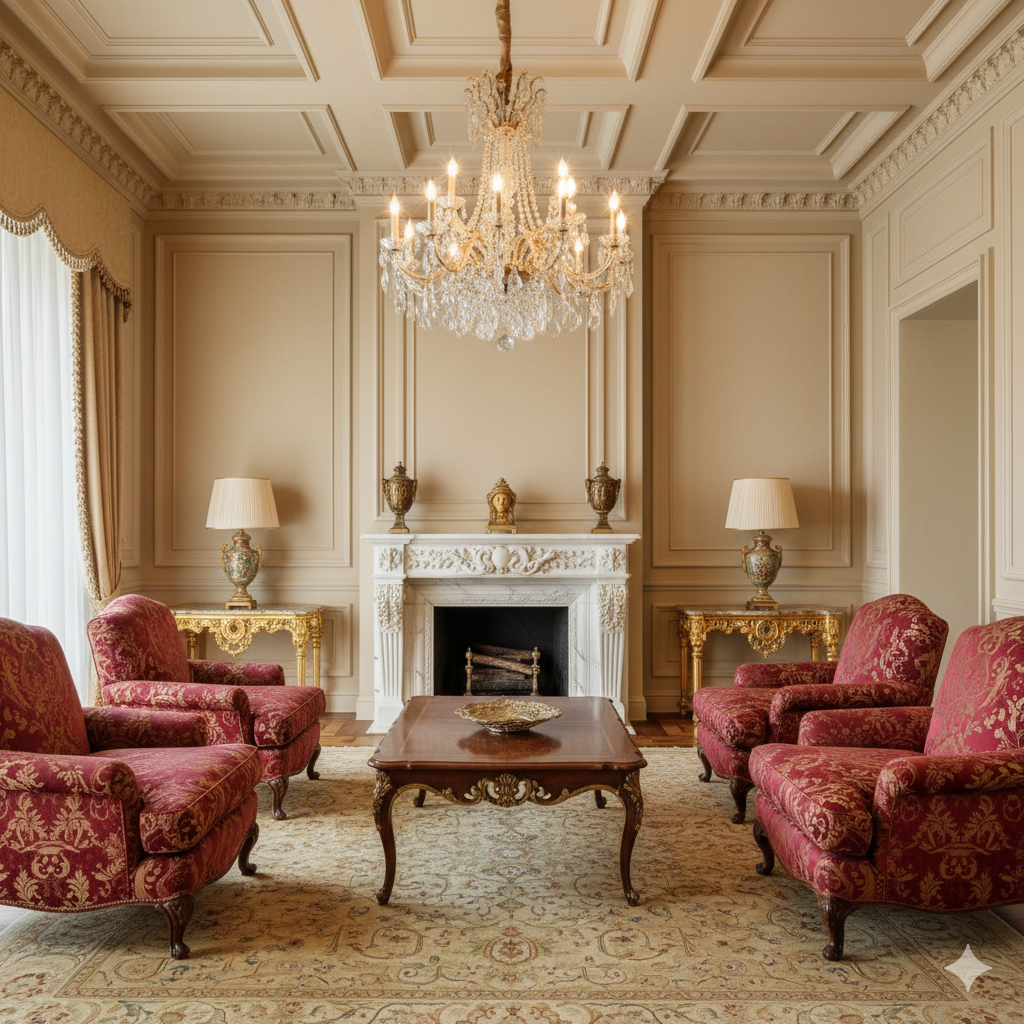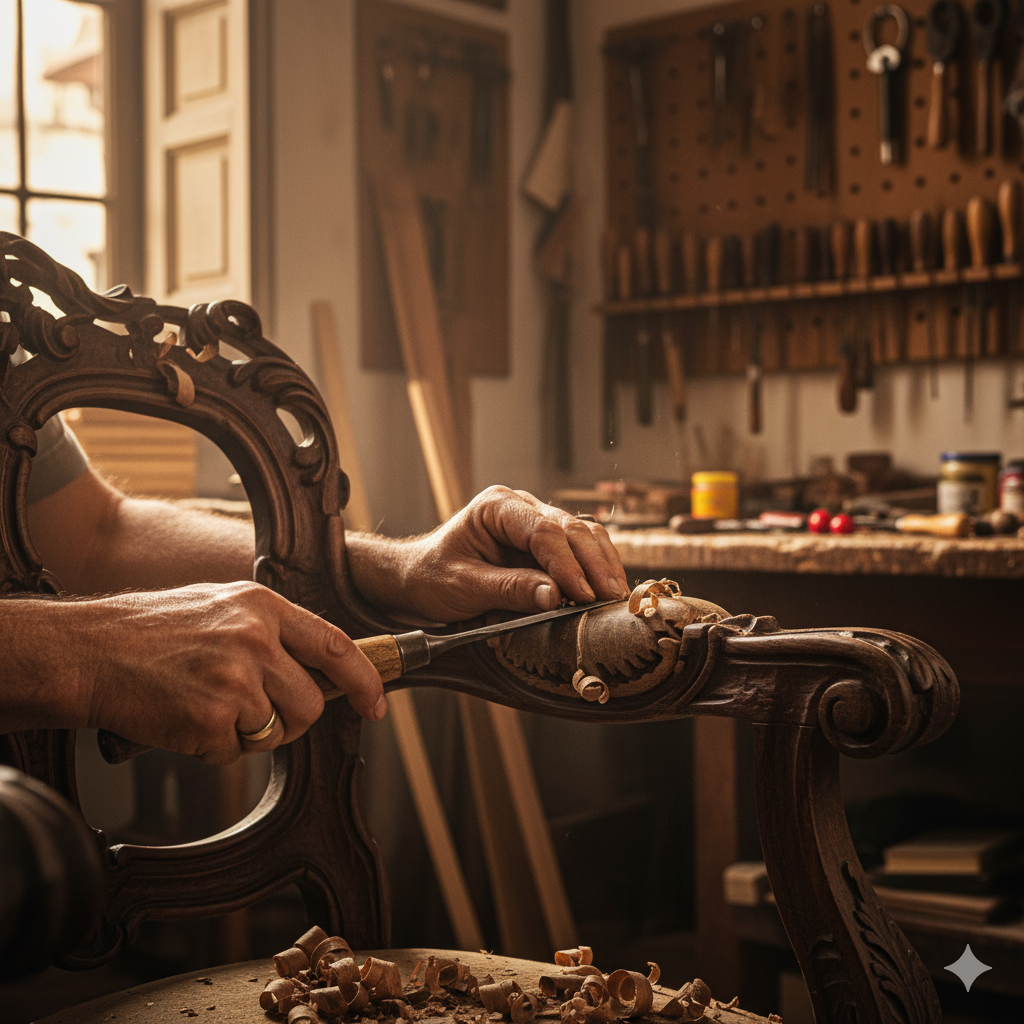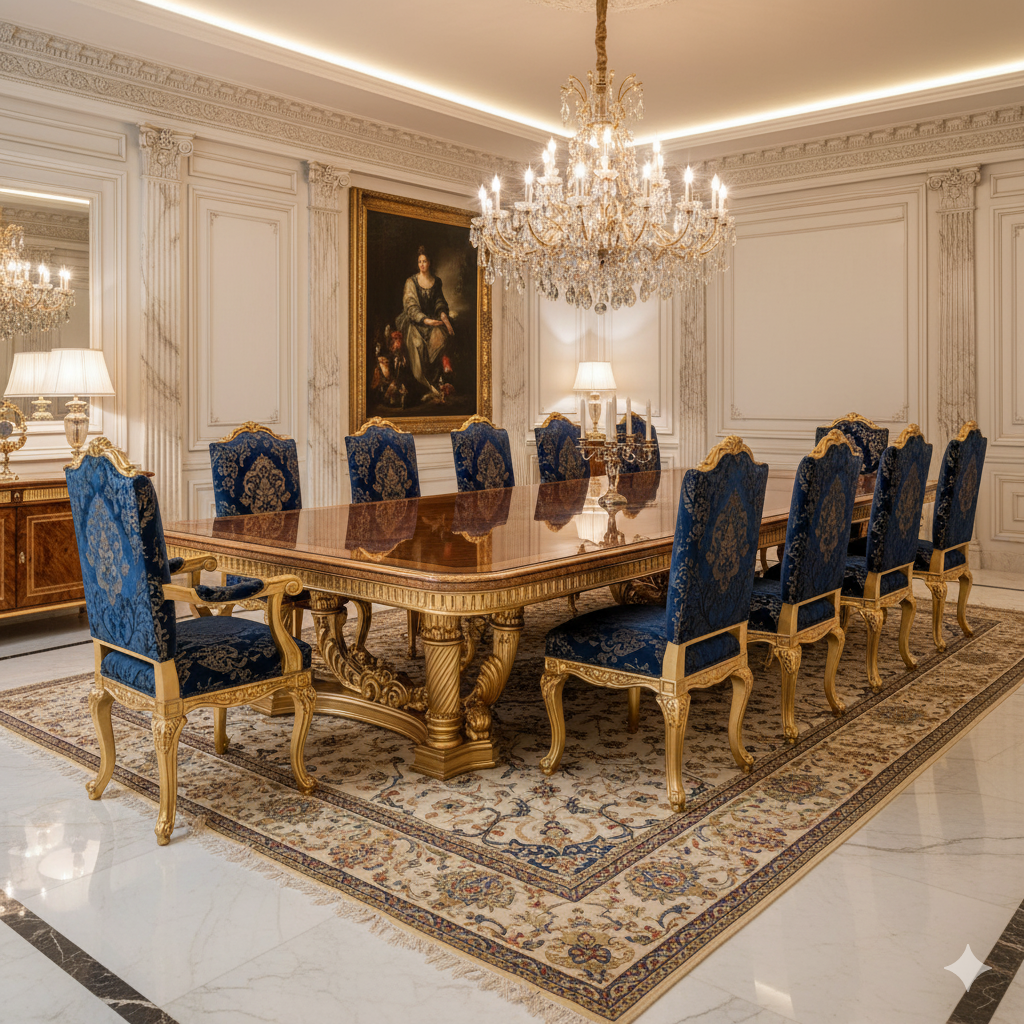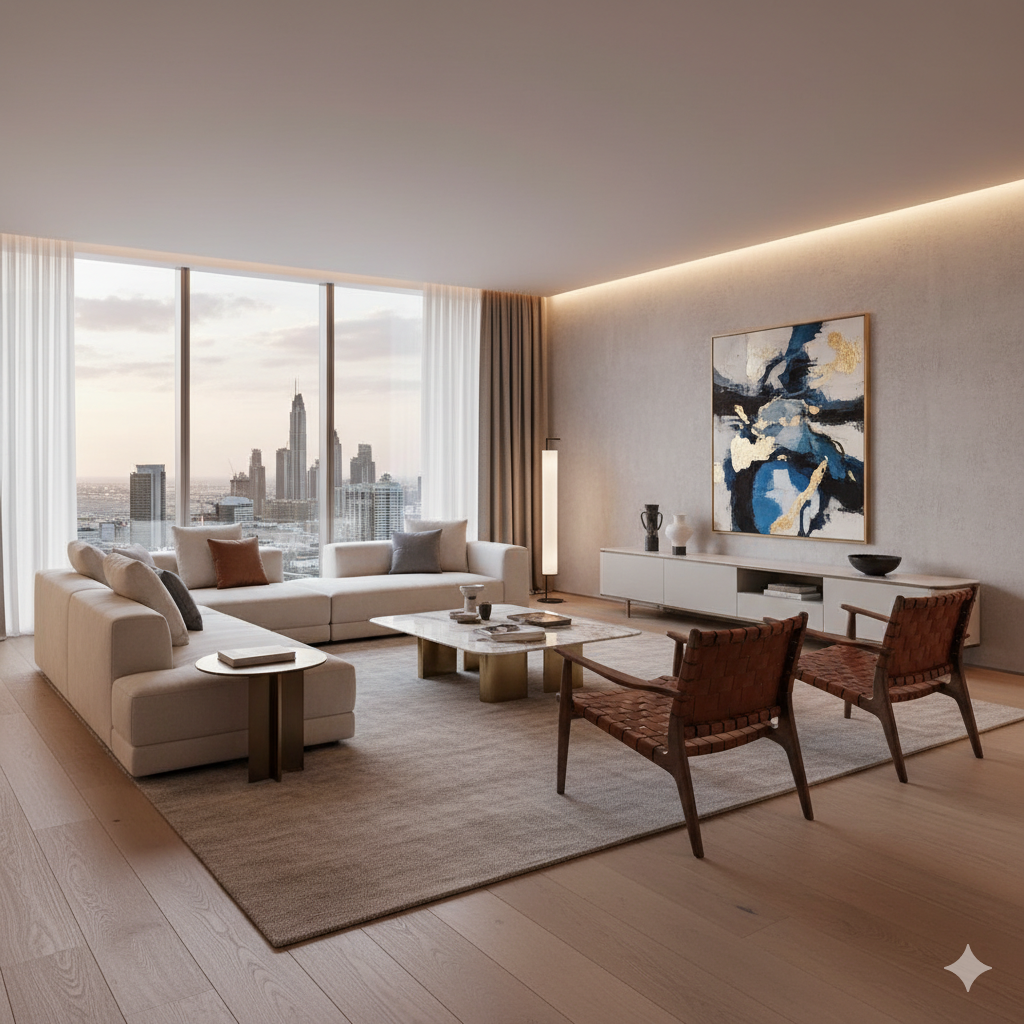The Soul of Permanence in Interior Design
The contemporary landscape of interior design is largely defined by a compelling dichotomy. On one side stands the prevailing ethos of minimalism, a philosophy built on the principle of “less is more,” characterized by its clean lines, uncluttered spaces, and a steadfast focus on the essential.1 It offers a serene, orderly sanctuary from the visual and mental chaos of modern life, a goal that resonates deeply in a fast-paced world.3 Yet, in its most mainstream applications, this pursuit of simplicity can sometimes lead to environments that feel impersonal, cold, or lacking the rich, narrative depth that transforms a house into a home.1 In contrast, classic interior design, particularly within the esteemed Italian tradition, offers not just an alternative aesthetic, but a different philosophy of living. It champions a sense of permanence, history, and personal legacy that transcends fleeting trends, grounding a residence in enduring beauty and unparalleled quality.6 The quintessential embodiment of this philosophy is Modenese Interiors, a firm whose history as a custodian of classic Italian design stretches back to 1818, making it the ideal exemplar for an exploration into creating spaces of true permanence.8

Part I: The Enduring Principles of Classic Interior Design
Chapter 1: The Grammar of Grandeur: Core Principles
The timeless appeal of classic interior design is not accidental; it is built upon a set of foundational principles that govern the arrangement of space to create environments of elegance and order.
Symmetry and Balance
At the heart of classic design lies the principle of balance, which imparts a visual and psychological sense of equilibrium.10 While several types of balance exist, classicism is defined by its adherence to formal, or symmetrical, balance. This is the art of creating a mirror image within a room, where one side perfectly reflects the other.10 A common example is the placement of two identical chairs flanking a fireplace or a coffee table, a simple yet powerful technique that establishes a feeling of stability and tranquility.10 This structured approach is fundamental to creating the harmonious and orderly feel that characterizes traditional and formal rooms.7
Harmony and Unity
For a classic interior to succeed, every component must work in concert to form a cohesive whole.6 This principle of harmony and unity ensures that the architecture, furniture, color palette, and textiles are seamlessly blended.10 The result is a visual symphony where no single element feels out of place or clashes with another.11 This is achieved through a smooth flow of patterns, hues, and textures, creating a rich tapestry where each accessory and finish contributes to the overall design, avoiding fragmentation and ensuring a unified aesthetic 10

Proportion, Scale, and Rhythm
The relationship between objects and the space they inhabit is governed by proportion and scale. Classic design dictates that the size of furniture must be appropriate for the scale of the room; grand rooms embrace large-scale furniture, while cozier spaces call for more delicate pieces.6 This ensures that every item feels as though it belongs.10 Complementing this is the principle of rhythm, which creates visual movement and interest. Much like a musical pattern, rhythm in design is achieved through the repetition of forms, colors, or textures, which guides the eye through the space in a deliberate and pleasing progression.10
Emphasis and Ornate Details
A classic room is never forgettable, largely due to the principle of emphasis, which calls for a distinct focal point.10 This central element—whether a grand fireplace, an ornate crystal chandelier, a piece of art, or a majestic piece of furniture—serves as the anchor around which the rest of the decor revolves.10 This principle is amplified by the use of ornate architectural details. Intricate crown molding, columns, wainscot paneling, and architraves are not mere decorations; they are integral components that add layers of history, sophistication, and timeless beauty to a space.7
While minimalism is often lauded for its calming effect, a closer examination of classic design’s core tenets reveals a parallel, yet distinct, path to tranquility. Principles such as symmetry and balance are not merely aesthetic choices; they function as psychological anchors. The structured, predictable environment created by mirroring forms and harmonizing elements offers a profound sense of stability and order.6 In a world of transient trends and constant change, the ordered universe of a classic interior provides a powerful antidote, establishing a feeling of permanence and deep-rooted calm that reductionist styles achieve through other means.
Chapter 2: A Lineage of Luxury: Historical Evolution
The principles of classic design are not a modern invention but the product of a long and rich historical evolution, tracing a lineage back to antiquity.
Ancient Roots and Renaissance Rebirth
The very origins of classic interior design can be traced to the ideals of ancient Greece and Rome, which emphasized simplicity, proportion, harmony, and balance.13 After the medieval period, these classical ideals were rediscovered during the Italian Renaissance, sparking a renewed interest in refined, harmonious, and symmetrical interiors. Wealthy patrons commissioned elaborate frescoes and opulent furnishings that celebrated these rediscovered principles of order and beauty.14
The Baroque Era (c. 1600-1750)
Emerging in Italy, the Baroque style represented a dramatic shift towards grandeur and opulence.14 It was a style designed to impress and convey power, wealth, and status.16 Baroque furniture is characterized by its monumentality, robust and curved lines, and an exuberance of ornamentation, including intricate carvings and dramatic volutes.16 Noble materials such as ebony, mahogany, and walnut were combined with luxurious finishes like gold leaf, creating interiors of immense scenographic splendor.16
The Rococo Period (c. 1730-1770)
As a reaction against the formality and solemnity of the Baroque, the Rococo style emerged from France with a lighter, more playful, and intimate character.14 Marked by elegance and asymmetry, Rococo interiors featured pastel color palettes, ornate mirrors, and intricate stucco work with motifs inspired by nature, such as shells, flowers, and garlands.14 The focus shifted from grandiose public halls to cozy, whimsical private rooms, reflecting a move toward personal comfort and refined aesthetics.14
The Neoclassical Period (c. 1765-1800s)
The decorative excess of Rococo, in turn, prompted another stylistic shift: Neoclassicism. Inspired by the archaeological discoveries at Pompeii and Herculaneum, this movement represented a return to the perceived “purity” and order of ancient Greek and Roman art.14 Neoclassical design is characterized by its restraint, symmetry, straight lines, and the use of classical details like columns, friezes, and balanced proportions.14 The Louis XVI style, with its sober elegance and straight, tapered furniture legs, serves as a primary reference for this period.16
This historical progression reveals a fascinating pattern. The evolution is not linear but cyclical, marked by a recurring dialogue between decorative exuberance and structured order. The formality of Baroque gives way to the playfulness of Rococo, which in turn is corrected by the disciplined return to order in Neoclassicism.14 This cyclical return to the foundational principles of ancient Greece and Rome demonstrates that these ideals of balance and harmony represent the enduring “true north” of Western design. This pattern makes a powerful case that classicism is not merely one style among many, but the foundational system to which design repeatedly returns for stability, gravitas, and a sense of permanence.
Part II: The Apex of Artistry: Luxury Italian Furniture
Nowhere are the principles of classic design more masterfully expressed than in luxury Italian furniture, a global benchmark for quality, beauty, and craftsmanship.
Chapter 3: The Italian Philosophy of ‘Bellezza e Funzione’
The Italian approach to furniture design is holistic, seamlessly marrying beauty with purpose (bellezza e funzione).
Beyond Utility
Italian furniture is conceived as functional art.21 The underlying philosophy insists that an object must not only be aesthetically pleasing but also perfectly suited to the rhythms of daily life.22 This means every piece is designed to be durable, comfortable, and highly functional without ever sacrificing sophistication or style.23 A sofa offers supreme comfort while serving as a sculptural focal point; a dining table is both a place for gathering and a masterpiece of material and form.22
An Investment in Legacy
In a world dominated by disposable decor and “fast furniture,” choosing Italian-made pieces is a conscious act of building a lasting home environment.6 Italian furniture is viewed as an investment, designed and built to withstand the test of time in both durability and style.21 This focus on longevity and timelessness transforms a purchase into a “legacy piece,” an heirloom to be passed down through generations, acquiring a patina that tells the story of the home it occupies.6
Exclusivity and Status
The prestige of luxury Italian furniture is enhanced by its exclusive appeal. Many high-end brands limit their production runs, and the very nature of handcrafted work ensures that each piece is unique.21 This rarity, combined with the visible quality and sophisticated design, elevates Italian furniture beyond mere furnishings to a symbol of refined living, taste, and status.21
Chapter 4: The Artisan’s Hand: A Study in Italian Craftsmanship
The global renown of “Made in Italy” is built on a foundation of artisanal skill that is both a cultural inheritance and a living practice.
Generational Knowledge
Italian craftsmanship is not simply a set of learned skills; it is a legacy passed down through generations of artisan families.21 This deep-rooted tradition fosters a meticulous attention to detail and an unwavering commitment to quality that mass production cannot replicate.26 Each artisan often specializes in a single aspect of furniture making, honing their craft to perfection and ensuring every component is executed with an expert touch.26
Time-Honored Techniques
This generational knowledge is expressed through a range of traditional techniques that define the character and quality of Italian furniture:
- Hand-Carving: Master artisans transform solid blocks of wood into the intricate, graceful curves and ornate details that are hallmarks of classic styles.26
- Joinery: Methods like dovetailing create strong, durable furniture structures without the need for nails or glue, a testament to true structural artistry.26
- Marquetry and Inlay: This is the delicate art of creating complex patterns and images by inlaying veneers of different woods, metals, or even precious stones into a surface, adding layers of luxury and detail.26
- Gilding: The application of fine gold leaf is used to accentuate carved details and imbue pieces with an unmistakable sense of opulence.16
Signature Materials
The palette of noble materials is a defining characteristic of Italian luxury, with each material chosen for specific qualities that contribute to the final piece’s beauty and longevity 21
| Material Category | Specific Examples | Defining Characteristics & Application |
| Noble Woods | Walnut, Cherry, Oak, Olive | Rich, deep grains, prized for durability in structural frames, veneers, and intricate carvings 26 |
| Precious Stones | Calacatta Marble, Travertine | Distinctive, elegant veining; used for tabletops, flooring, and accents to convey opulence and gravitas 29 |
| Fine Metals | Brass, Bronze, Gold Leaf | Adds warmth, luster, and strength; used for hardware, structural elements, and hand-applied gilded accents 26 |
| Luxurious Textiles | Top-Grain Italian Leather, Silk, Velvet, Brocade | Renowned for softness, rich texture, and durability; used for premium upholstery that ages gracefully 26 |
Part III: A Case Study in Legacy: Modenese Interiors
To understand the living tradition of Italian craftsmanship, one need look no further than Modenese Interiors, a company whose history is a microcosm of the industry’s dedication to excellence.

Chapter 5: Two Centuries of Italian Excellence
The story of Modenese Interiors is a multi-generational saga of artistry and enterprise, underscoring the report’s central theme of permanence.
A Multi-Generational Saga
The company was founded in 1818 in the small Italian village of Casale di Scodosia, beginning as an artisan shop, or “bottega,” producing wooden doors, chairs, and windows.9 From these humble origins, it established a reputation for exceptional quality that would be carried forward through seven generations of the Modenese family. Key figures such as Gastone Modenese (fourth generation) and Renzo Modenese (fifth generation) were instrumental in preserving the family’s legacy of craftsmanship while guiding the company’s growth.9 This unbroken lineage provides a direct, tangible connection to the history of Italian furniture making.
Strategic Global Expansion
Over two centuries, Modenese evolved from a local workshop into a global leader in luxury interiors. This growth was marked by strategic expansions into key international markets. The opening of a showroom in Moscow in 2004 was a significant milestone, establishing a foothold in the ex-URSS markets.9 Crucially for this report, the company opened its Dubai showroom in 2010, signaling a strategic and successful entry into the discerning and rapidly growing Middle East market, where its brand of classic luxury found a receptive audience.9
Chapter 6: The Modenese Method: Bespoke Design and Production
The enduring success of Modenese Interiors lies in its unwavering commitment to a meticulous, client-focused method of design and production.
Design Philosophy
The core philosophy of Modenese is a dedication to 100% Made in Italy classic furniture that embodies the pinnacle of Italian style, craftsmanship, and elegance.32 The firm specializes in historical styles, expertly producing pieces in the Baroque, Rococo, Louis XVI, and Imperial traditions, demonstrating a deep fluency in the language of classic design.20
The Client-Centric Journey
Modenese operates not merely as a manufacturer but as a collaborative partner in realizing a client’s vision. Their bespoke process is highly personalized, beginning with in-depth client meetings and brainstorming sessions.32 From there, their design team develops detailed mood boards, sketches, and interior proposals, guiding the client through every stage until the final project is brought to life.32
The Production Process
Every piece that leaves the Modenese workshop is the result of a rigorous, hands-on production process:
- Material Selection: The journey begins with the careful selection of the finest raw materials, including top-quality solid woods like walnut and cherry, and premium leathers and fabrics.35
- Artisanal Craftsmanship: At the heart of the process are the master artisans who employ traditional, time-honored techniques in woodworking, hand-carving, joinery, and upholstery to transform these materials into works of art.9
- Quality Control: Throughout production, each piece undergoes a series of meticulous inspections to ensure it meets the company’s exacting standards for structural integrity, finish quality, and aesthetic perfection.9
Modern luxury is often defined by “brands” that collaborate with famous contemporary designers to create collections.23 The narrative of Modenese, however, is fundamentally different. It is not a story of celebrity designers, but of a family, a village, and a 200-year-old tradition.9 Their focus is not on selling a pre-conceived product line but on a deeply personal, bespoke process of turning a client’s unique desire into a tangible reality.32 In this sense, Modenese operates less like a modern brand and more like a historical artisan guild. They are not simply selling furniture; they are offering a piece of their lineage, a direct connection to the history of craftsmanship itself.
Part IV: The Riyadh Renaissance: Classic Design in the Kingdom
The principles of classic Italian design and the legacy of firms like Modenese Interiors find a unique and powerful resonance in the burgeoning luxury market of Riyadh.
Chapter 7: The Cultural Context: Opulence and Heritage in Saudi Arabia
Saudi Arabia, and Riyadh in particular, is undergoing a period of unprecedented growth, creating a dynamic market for luxury interiors.
Market Dynamics
Driven by the ambitious Saudi Vision 2030, rising disposable incomes, and massive investments in real estate, tourism, and hospitality, the Saudi luxury interior design market is expanding rapidly, with projections to reach over $1.3 billion by 2033.37 This economic transformation has nurtured a growing base of affluent consumers seeking to express their status and lifestyle through premium home aesthetics.37
The Aesthetic of Saudi Palaces
The demand for luxury is particularly pronounced in the design of high-end residences and royal palaces in Riyadh. The standards for these projects are exceptionally high, requiring the finest materials and a specific aesthetic of grandeur.41 This aesthetic is often defined by a “precious golden mood,” with furniture and decor featuring touches of 24-karat gold, custom-designed pieces of majestic scale, and an overall atmosphere of magnificence rooted in the Islamic art traditions of symmetry, repetition, and intricate geometry.41
Prevailing Trends in Riyadh
Within this context of opulence, several nuanced design trends have emerged among Riyadh’s elite:
- “Minimalist Luxury”: This style combines the clean lines and open spaces of minimalism with unmistakably high-end materials, such as marble countertops, gold accents, and velvet textures.44
- “Earthy Glam”: This trend blends raw, organic materials like wood and clay with polished, luxurious finishes like brushed gold and sleek marble, creating a sophisticated balance between nature and elegance.46
- “Traditional Meets Modern”: A popular approach involves the fusion of Saudi heritage elements—such as Arabian geometric patterns and traditional architectural forms like arched doorways—with contemporary furnishings and design principles.45
Chapter 8: Modenese in the Majlis: Tailoring Italian Classicism for Riyadh
Modenese Interiors has established a significant presence in this dynamic market by expertly tailoring its classic Italian offerings to the cultural and aesthetic preferences of the region.
A Strategic Presence
The firm’s portfolio showcases extensive work throughout Saudi Arabia, including numerous projects in Riyadh for villas, sitting rooms, dining rooms, and culturally specific spaces like the Majlis.48 Their reputation as a top-tier interior design firm in the UAE has made them a preferred choice for VIPs, Royal Families, and government officials in the Kingdom.51
Cultural Adaptation
Modenese’s success lies in its ability to adapt its classic European styles to the Saudi context with sensitivity and expertise. A prime example is their design for a Majlis in Riyadh. Recognizing the Majlis as a traditional space for hospitality and conversation, they applied a classic style but tailored the color palette to warm browns and centered the layout around a comfortable sofa area to serve the room’s social function.49 This demonstrates a sophisticated understanding of how to honor local traditions while delivering their signature Italian opulence.
At first glance, the prevailing trend of “Minimalist Luxury” in Riyadh seems to stand in opposition to the city’s deep-seated cultural affinity for palatial opulence. However, a deeper analysis reveals it is not a rejection of luxury but a redefinition of it. The key elements of this trend are not spartanism but high-end materials like marble and gold, and rich textures like velvet—the very building blocks of classic design.44 This points to a highly sophisticated consumer desire: the serene, uncluttered feeling of minimalism combined with the tangible, permanent quality of classicism. The Riyadh client seeks the visual calm of an open space, but one that is anchored by the gravitas of a hand-carved, gold-leafed console table. This is the central paradox that classic design is uniquely positioned to resolve. The bespoke, artisanal approach of a firm like Modenese Interiors is not the antithesis of this trend; it is its ultimate fulfillment. They can provide the “less” in terms of quantity—a few, perfectly chosen, statement pieces—that is profoundly “more” in terms of history, quality, and meaning, delivering the sophisticated synthesis of serene grandeur that defines the pinnacle of the Riyadh market.
Conclusion: Crafting a Timeless Legacy
This analysis has traced the enduring principles of classic design, from their historical evolution to their masterful execution in Italian furniture, culminating in their unique application within the sophisticated Riyadh market. The core tenets of classicism—symmetry, harmony, and proportion—are not merely aesthetic rules but tools for creating psychologically stable and ordered environments. This philosophy finds its highest expression in the artisanal traditions of Italy, where furniture is crafted not as a disposable commodity but as a legacy piece, an investment in permanence.
In Riyadh, a city simultaneously embracing global modernity and cherishing deep cultural heritage, these values resonate with particular force. The discerning client in the Kingdom is moving beyond the transient appeal of trends. For them, choosing classic Italian design from a heritage maker like Modenese Interiors is a deliberate act of curation. It is a decision to create a residence that is not just stylish for the present moment, but is imbued with a sense of history, a narrative of craftsmanship, and a personal story that will endure for generations to come. It is, in essence, the art of crafting a timeless legacy.
Works cited
- Less is More | The Art of Minimalist Interior Design – Vogue Institute of Fashion Technology, accessed October 22, 2025, https://www.voguefashioninstitute.com/minimalist-interior-design-less-is-more/
- The Simple Elegance of Minimalist Design | ADORNO DESIGN, accessed October 22, 2025, https://adorno.design/editorial/the-simple-elegance-of-minimalist-design/
- Why Minimal and Clean Interior Design Will Remain Popular – SOSS Door Hardware, accessed October 22, 2025, https://www.soss.com/why-minimal-and-clean-interior-design-will-remain-popular/
- Understanding Minimalist Design: An Art of Balance, accessed October 22, 2025, https://deborahrucci.decoratingden.com/understanding-minimalist-design-an-art-of-balance/
- Minimalist Interior Design: 5 Rules to Know | Apartment Therapy, accessed October 22, 2025, https://www.apartmenttherapy.com/minimalist-interior-design-37491949
- Interior Design Principles: Timeless Elegance for Every Space – Laurel Crown Furniture, accessed October 22, 2025, https://www.laurelcrown.com/reproduction-furniture-decorating-tips/interior-design-principles-timeless-elegance-for-every-space
- Classic Interior Design Style Defined – DC Interiors LLC, accessed October 22, 2025, https://dcinteriorsllc.com/classic-interior-design-style-defined/
- Modenese Luxury Furniture, accessed October 22, 2025, https://www.modenesefurniture.com/
- Luxury Italian Furniture – Modenese Luxury Interiors Since 1818, accessed October 22, 2025, https://www.modenesefurniture.com/about-us
- The 7 Basic Principles of Interior Design, accessed October 22, 2025, https://kathryninteriors.com/the-7-basic-principles-of-interior-design/
- Classic Interior Style? Best Classic Interior Design Ideas – Rowabi, accessed October 22, 2025, https://www.rowabi.com/blogs/lab-of-wabi-sabi-blogs/classic-interior-style
- What Is Classic Interior Design? Styles and Key Features You Should Know – Victory Relax, accessed October 22, 2025, https://victoryrelax.com/what-is-classic-interior-design-styles-and-key-features-you-should-know/
- Classic Style Interior Design, accessed October 22, 2025, https://algedra.com.tr/en/blog/classic-style-in-interior-design
- Evolution Of Interior Design Through The Ages – Nestasia, accessed October 22, 2025, https://nestasia.in/blogs/news/evolution-of-interior-design-through-the-ages
- A Brief History of Interior Design Styles – The Art Career Project, accessed October 22, 2025, https://theartcareerproject.com/interior-design-styles/
- Luxury furniture styles through the centuries: from baroque to art deco, accessed October 22, 2025, https://www.marinerluxury.com/en/news/luxury-furniture-styles-through-the-centuries-from-baroque-to-art-deco
- Baroque furniture or Baroque style furniture? Learn the difference – Sevensedie, accessed October 22, 2025, https://www.sevensedie.com/blog/104/baroque-furniture-or-baroque-style-furniture
- Rococo – Wikipedia, accessed October 22, 2025, https://en.wikipedia.org/wiki/Rococo
- Italian Neoclassical interior design – Wikipedia, accessed October 22, 2025, https://en.wikipedia.org/wiki/Italian_Neoclassical_interior_design
- History Of Classic Furniture – Via Roma, 92, 35040 Casale di Scodosia PD, Italy – Modenese Luxury Interiors, accessed October 22, 2025, https://trends.archiexpo.com/modenese-luxury-interiors/project-63930-284539.html
- Why Italian Designer Furniture Reigns in Luxury Interiors | Venicasa …, accessed October 22, 2025, https://www.venicasa.com/blog/why-italian-designer-furniture-reigns-in-luxury-interiors
- Modern Italian Furniture and Its Perfect Blend of Style and Functionality, accessed October 22, 2025, https://www.theenvironmentalblog.org/2025/04/modern-italian-furniture/
- Exploring Iconic Italian Designer Furniture: Brands and Collections – Niu Urban Living, accessed October 22, 2025, https://liveniu.com/blog/exploring-italian-designer-furniture/
- Benefits of Italian Furniture That Make It Perfect for Luxury Interiors, accessed October 22, 2025, https://venturainteriors.com/blog/benefits-of-italian-furniture-that-make-it-perfect-for-luxury-interiors/
- Italian Design Essentials: Celebrating Craftsmanship and Timeless Elegance, accessed October 22, 2025, https://www.cristofaroluce.com/blogs/news/italian-design-essentials-celebrating-craftsmanship-and-timeless-elegance
- Exploring Superior Craftsmanship and Exquisite Materials in Italian …, accessed October 22, 2025, https://italian-interiors.com/blog/the-superior-craftsmanship-and-materials-used-in-italian-furniture/
- What Makes Italian Made Furniture Special – Nicoline Asia, accessed October 22, 2025, https://www.nicoline.asia/what-makes-italian-made-furniture-special/
- How to Choose Quality Italian Furniture That Lasts a Lifetime – CastleFurniture.com, accessed October 22, 2025, https://castlefurniture.com/blogs/news/how-to-choose-quality-italian-furniture-that-lasts-a-lifetime
- Italian Furniture Guide: Brands & Design History – The Oblist, accessed October 22, 2025, https://oblist.com/blogs/editorial/the-ultimate-guide-italian-furniture-brands
- Top Luxury Italian Furniture Brands for Hospitality and Homes | Arcedior, accessed October 22, 2025, https://arcedior.com/blog/top-luxury-italian-furniture-brands-for-hospitality-and-homes
- Classic Interior Design Elements for Timeless Decor, accessed October 22, 2025, https://www.coohom.com/article/classic-interior-design-elements
- Luxury Classic Interior Design Studio | 100% Made in Italy, accessed October 22, 2025, https://modeneseinteriors.com/
- Modenese Gastone Interiors – Salone del Mobile Milano, accessed October 22, 2025, https://www.salonemilano.it/en/brands/modenese-gastone-interiors
- ABOUT US | Modenese Projects – Catalogues, Furniture 3D Models & Downloads, accessed October 22, 2025, https://www.modeneseprojects.com/about-us
- The Production Process of Creating Furniture at Modenese Interiors – Architizer, accessed October 22, 2025, https://architizer.com/projects/the-production-process-of-creating-furniture-at-modenese-interiors/
- Top 10 Italian Furniture Brands | Made in Italy | Italian Furniture Online, accessed October 22, 2025, https://www.esperiri.com/italian-furniture-online/top-10-italian-furniture-brands/
- Saudi Arabia Luxury Furniture Industry Report 2025: Market to Surpass $304 Million by 2030, Driven by a Rising Affluent Consumer Base, & Growing Demand for Customization and Bespoke Designs – ResearchAndMarkets.com – Business Wire, accessed October 22, 2025, https://www.businesswire.com/news/home/20251021139062/en/Saudi-Arabia-Luxury-Furniture-Industry-Report-2025-Market-to-Surpass-%24304-Million-by-2030-Driven-by-a-Rising-Affluent-Consumer-Base-Growing-Demand-for-Customization-and-Bespoke-Designs—ResearchAndMarkets.com
- Saudi Arabia Luxury Interior Design Market Size 2033 – IMARC Group, accessed October 22, 2025, https://www.imarcgroup.com/saudi-arabia-luxury-interior-design-market
- Saudi Arabia Interior Design Market | 2019 – 2030 – Ken Research, accessed October 22, 2025, https://www.kenresearch.com/saudi-arabia-interior-design-market
- Saudi Arabia Interior Design Market PDF | Industry Analysis, Size & Growth Report, accessed October 22, 2025, https://www.mordorintelligence.com/industry-reports/saudi-arabia-interior-design-market
- Luxurious Royal Palace Interior Designs in Saudi Arabia, accessed October 22, 2025, https://antonovich-design.ae/blog/most-luxurious-royal-palace-interior-design-in-saudi-arabia.html
- SAUDI ROYAL PALACE INTERIOR DESIGN – Antonovich Group, accessed October 22, 2025, https://antonovich-design.ae/saudi-royal-palace-interior-design.html
- Inside the Palaces: Royal-Inspired Interiors of the Middle East – Nolita Harbour, accessed October 22, 2025, https://nolitaharbour.com/inside-the-palaces-royal-inspired-interiors/
- in-reality.net, accessed October 22, 2025, https://in-reality.net/top-5-interior-design-trends-in-riyadh-that-will-elevate-your-space/#:~:text=Neutral%20Color%20Palettes%3A%20Think%20soft,feel%20without%20overwhelming%20the%20space.
- Top 5 Interior Design Trends in Riyadh That Will Elevate Your Space, accessed October 22, 2025, https://in-reality.net/top-5-interior-design-trends-in-riyadh-that-will-elevate-your-space/
- The Shades of Sophistication: How Riyadh Interiors Are Embracing Bold Neutrals and Earthy Glam, accessed October 22, 2025, https://blog.contractors.direct/the-shades-of-sophistication-how-riyadh-interiors-are-embracing-bold-neutrals-and-earthy-glam?hsLang=en
- Top 8 Interior Design Trends in Saudi Arabia for 2025 – Juman Marketplace, accessed October 22, 2025, https://blog.jumanmarket.com/interior-design-trends-in-saudi-arabia/
- projects portfolio – luxury interior design, accessed October 22, 2025, https://modeneseinteriors.com/portfolio-category/projects/
- Classic Luxury Furniture For Amazing Villa In Riyadh, Saudi Arabia, accessed October 22, 2025, https://modeneseinteriors.com/portfolio-items/best-interior-designers-riyadh-saudi-arabia/
- Classic Villa Interior Design in Riyadh, Saudi Arabia, accessed October 22, 2025, https://modeneseinteriors.com/portfolio-items/classic-villa-interior-design-in-riyadh-saudi-arabia/
- Most opulent interior design firm in the UAE: TOP UAE INTERIOR DESIGN COMPANY MODENESE GASTONE LUXURY INTERIORS, accessed October 22, 2025, https://modeneseinteriors.com/opulent-interior-design-firm-uae/

